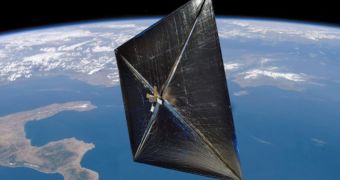Now that the Japanese Aerospace Exploration Agency (JAXA) has demonstrated the feasibility of solar sails for practical applications, NASA is eager to follow in its footsteps, having already launched its first such spacecraft.
The Japanese agency launched the IKAROS demonstrator on May 21, 2010, aboard the same H-IIA delivery system that carried the Venus weather satellite Akatsuki to space.
JAXA demonstrated that light can indeed propel the small satellite, and that maneuvers such as turns are indeed possible. NASA is currently getting ready to activate its own solar sail.
The American probe was launched aboard a Minotaur IV delivery system on Friday, November 19. Called Nanosail-D, the demonstrator took off alongside several other satellites, from the Kodiak Island spaceport, in Alaska.
However, it was only yesterday, December 6, that the satellite was ejected from its payload fairing, and made ready for full deployment. None of its solar sails have yet been opened, mission controllers say.
The loaf of bread-sized spacecraft was deployed from aboard a carrier vehicle, the Fast, Affordable, Science and Technology Satellite (FASTSAT), at around 1:31 am EST (0631 GMT), Universe Today reports.
The sails themselves are made out of ultra-thin, light materials. The ones on Nanosail-D are made out of the polymer CP1, NASA experts say. The satellite will be deployed at an orbital altitude of about 650 kilometers (400 miles) above the surface of the planet.
One of the most important applications for solar sails could be to act as aerobreaks for large satellites. After the spacecrafts end their service life, deploying the sails could produce enough drag to destabilize their orbits, and force then to burn up during atmospheric reentry.
NASA experts explain that, given the close proximity Nanosail-D is to Earth, actually navigating by using sunlight is not necessarily the main goal of the mission.
They say that the largest engineering challenge of such missions is the actual deployment of the sails, when they go from being tightly-packed inside specialized containers to fully-stretched and ready.
“The deployment works in the exact opposite way of carpenter’s measuring tape. With a measuring tape, you pull it out, which winds up a spring, and when you let it go it is quickly pulled back in,” says expert Dean Alhorn.
“With NanoSail-D, we wind up the booms around the center spindle. Those wound-up booms act like the spring. Approximately seven days after launch, it deploys the sail off the center spindle,” he adds.
Alhorn, who is based at the NASA Mshall Space Flight Center, in Huntsville, Alabama, is the principal investigator and aerospace engineer for Nanosail-D.

 14 DAY TRIAL //
14 DAY TRIAL //